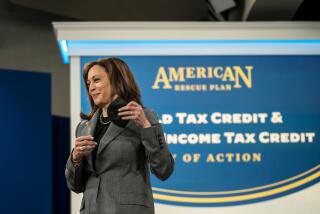Gephardt Offers His Version of Tax Reform : Revenue: The Democrat’s plan calls for a 10% rate for low-income earners. He says half of all wage earners would not have to file an income tax return.
- Share via
WASHINGTON — House Minority Leader Richard A. Gephardt (D-Mo.) Thursday outlined an income-tax plan that would combine the simplicity of Republican proposals with the middle-class benefits championed by Democrats.
In a speech to the Center for National Policy, a Democratic-oriented think tank, Gephardt proposed cutting the income-tax rate for most Americans to 10% and abolishing all major deductions except for mortgage interest.
Such a simplification, said Gephardt, would make it unnecessary for half of Americans even to file income tax returns, while most of the rest could complete their statements on a postcard-size form.
But while three-quarters of Americans would pay lower--and simpler--taxes under Gephardt’s plan, upper-income Americans, who tend to make heavy use of deductions and credits, would pay more. The Gephardt plan would establish tax brackets of 20%, 26%, 32% and 34% for single people with taxable income of more than $24,050 or for married couples with taxable income above $40,200. The highest rate of 34% would fall on individuals or couples making more than $264,450.
“My 10% tax is unapologetically progressive,” said Gephardt. “Those who enjoy more of society’s benefits should shoulder a little more of its burdens.”
Gephardt’s proposal is the latest in a flurry of initiatives designed to streamline taxes but it is the first plan by a Democrat. House Majority Leader Dick Armey (R-Tex.) has proposed a flat tax and House Ways and Means Committee Chairman Bill Archer (R-Tex.) has said that he favors a consumption tax. Gephardt criticized Armey’s plan as “the largest redistribution of income in the history of the country” from the poor and middle class to the rich.
*
Gephardt called his plan the “10% tax” because three-in-four Americans would pay that rate. The first $19,000 for families of four and $7,800 for individuals would be tax-exempt, and so would interest paid on home mortgages. Other exemptions would be eliminated.
However, Gephardt would require workers to include the value of fringe benefits, such as health care, in their earnings. And he would continue to tax unearned income, such as stock dividends and capital gains, while Republican proposals would leave such income untaxed in an effort to stimulate savings and investment.
Armey ridiculed Gephardt’s proposal as “about as flat as the Rocky Mountains.”
More to Read
Get the L.A. Times Politics newsletter
Deeply reported insights into legislation, politics and policy from Sacramento, Washington and beyond. In your inbox twice per week.
You may occasionally receive promotional content from the Los Angeles Times.











